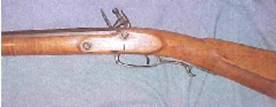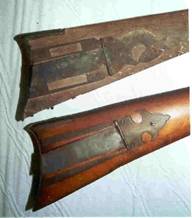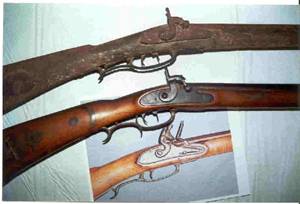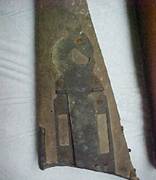BY JOHN T. MISSKELLEY
During the summer of 1999, The Culture and Heritage Commission of York County was having a fund-raiser at Hightower Hall, [an antebellum plantation at Historic Brattonsville, located near McConnells, South Carolina] to raise funds for the restoration of that building. Many of the 18th century interpreters at Historic Brattonsville, including myself, were asked to put on a weapons firing demonstration for the assembled crowd. After firing our weapons, we were able to intermingle with the people. My attire that day consisted of civilian clothing typical of the time period [1760-1785], along with a flintlock rifle, hunting bag and powder horn. My powder horn is a beautiful example of the type of workmanship that was seen on horns in the 18th Century. It is scrimshawed with a map showing the location of the Misskelly [1] family home place, south of present day York, South Carolina and in large letters are written: John Misskelley His Horn.
As I stood there talking, a man walked up to me, looked at my powder horn and asked if I was portraying Alexander Misskelly, the gunsmith! I said that Alexander was my G-G-G-Grandfather. I asked the gentleman what he knew of Alexander, and he replied that he knew of at least one of Alexander’s rifles were still in York County. Excited, I asked if he knew who owned it, but he did not. Later, that afternoon I ran across a gentleman who was very knowledgeable on York County and it’s history. He knew that I was searching for Misskelley family history, and anything or anyone who had information. I naively told him my story, and exclaimed that I wanted desperately to know who had the rifle and ultimately to see the weapon. As I finished my story, he looked at me with a smile on his face, and said he knew who owned it. I was very disappointed that he knew of a Misskelly rifle and never told me about it. I could feel my Scotch-Irish blood starting to rise. I felt betrayed and extremely dismayed that someone had kept information that meant so much to me unrevealed. I asked if he would tell me who owned it, so that I could make arrangements to see it. He could not tell me who owned the rifle because the owner had sworn him to secrecy. However, the gentleman did promise to talk with the owner of the rifle and see if I could get an audience with the weapon my G-G-G-Grandfather made. Regardless of the promised efforts to reunite me with the elusive Misskelly rifle, I spent a miserable weekend worrying over it. On Monday morning, I started my own quest to find the rifle.
Rock Hill, South Carolina is still, in essence, a small town and I had only been a resident for a few years. I thought that my limited time in town, would prevent me from getting far in my quest, but within a month, I had found the rifle. As of January 2002, I have found two Alexander Misskelly rifles. Most recently a third rifle has appeared, that could possibly be attributed to Alexander or William Misskelly, his father. As I began finding these rifles, I realized that I needed to research the history of long rifles in the York County, South Carolina area. Using information obtained from the York County Library in Rock Hill, as well as accessing will and probate records, I was able to glean the following history.
Around the time of the American Revolution, weapons were a necessity of everyday life in the New Acquisition District of South Carolina [Present day York County]. A resident had to protect their family and property from threats that ranged from Cherokee Indians, to animals such as wolves, panthers, and other large predators that would terrorize your livestock. Rifles, fowlers, shotguns and old military muskets were thus introduced into this recently acquired area of South Carolina. Where did they come from? We know that the new settlers of the New Acquisition were mainly coming from Pennsylvania, Maryland, Virginia, and North Carolina. After the French and Indian war ended [1754-1763] many of the families who had settled on the western boundaries of those colonies moved further south to try and escape from the Indian threat. A few settlers were also coming from Charlestown on the coast of the province of South Carolina.
The research that has been done on the gunsmiths of Pennsylvania, Maryland, Virginia and North Carolina is impressive. There is one work researching the gunsmiths of North and South Carolina, called Gunsmiths of Carolina, by James H. Whisker, et al. The list of gunsmiths is extensive, but appears to be incomplete. None of the gunsmiths named lived in the New Acquisition district, which after 1790 was called Camden District. The first notice, in my research, of a gunsmith working in the New Acquisition District is in the inventory of the estate of John Cunningham, recorded on November 1, 1783 it lists “One rifle barrel, lock and mountings.” [2] Then in a July 1788 court case between James Powell and David Adams, a local gunsmith, Alexander Clark was summoned as garnishee where he says, “He owes L. 8.2.4. Sterling and has in his possession one rifle gun barrel, a shot pouch, moulds and wipers, and a small piece of brass and no more.” [3] John Garvin, who recorded his will on October 7, 1799 says, “Also to my son William I give and bequeath to him also a gun barrel which Mr. Alex’r Clark is to make for me to him provided he finishes a wagon now on hand.” [4] These records are proof that firearms were being made in York District as early as the 1780’s and 90’s.
On October 5, 1778, Alexander Clark was a witness in the will of his brother-in-law James Misskelly, who died in 1779-80. In James Misskelly’s will he states, “Also my will and desire is that each of my s’d sons keeps their guns according to the manner they have in by past time distinguished them by.” His sons were James and William Misskelly, both veterans of the Revolutionary war. It is interesting how James describes that his sons were to keep their guns. It is well known that these early settlers were expert shots, and that the most difficult shots were made with ease. James Collins, a local boy living in the district relates what happened at the battle of Hucks Defeat [located near McConnells, South Carolina] on July 12, 1780,
“Before the body of Hook [5] was examined, two claimed the honor of killing
him; both showed their guns and named the part of his body they had
taken aim at, and both claimed the sword. One presented a large rifle,
the other a very small one. The person having the small gun, cried,
“I shot him! I shot him. I shot two balls which entered close under the
ear.” When Hook was examined, the two small balls were found to
have passed through the place as described.” [6]
It is unknown, which Carroll brother made this precise shot, but he hit exactly were he aimed, at a distance of 40 to 50 yards while Huck was on horseback! What an amazing feat, attesting to the accuracy of these backwoods rifleman.
Most of the weapons that were brought to the New Acquisition area from other
places are described as in the will of James Craig, which was recorded on September 3, 1778. Craig stated that, “Each of my beloved children here after named an equal share of my real and personal estate (except my son John whom I give one mare called Doll and my rifle gun over and above his equal share).” [7] When the New Acquisition District became active during the Revolution, [1780-1783] new weapons were introduced into the area. It was during this time that captured muskets make their first appearance. In Stephen Miller’s inventory in 1789, they list a “Musket gun” valued at L. 0. 5. 0. [8] Undoubtedly this musket was captured, or was a battlefield pick-up. It was not uncommon for the commander of the battle to split the spoils of war between the men. James Collins writes,
“The guns lay scattered over the field, [The battle of Fishing Creek]
also various articles of camp equipage. Among the guns there
was one picked up, a good looking rifle, with a shot bag and all the
apparatus belonging. The gun had apparently been laid down by
some one who intended taking a little sleep, in order to have her
ready when he awoke. The gun was presented to the Colonel, and
after viewing her sometime, he observed “well, boys I have a use for
this gun—I shall have to claim her of my part of the spoils.” Then calling
me up, said, “well James you have been wanting a rifle for sometime;
Here is one I think will suit you; She is light, and I think, a good one; She
has a excellent lock; Lay down your little shot gun; Take her, and take
good care of her.” [9]
These captured rifles and muskets generally stayed with their new owners until they died, and where then sold to others or willed to a family member. In the 1790 census in Camden District [now York Co.] Alexander Clark, the gunsmith, was shown with two white males over 16, 3 males under 16, and 2 females of 16 and older. Living in the next households were William and Solomon Clark respectively. It is not known if these are his brothers or sons. In the 1800 census of York district, William and Solomon Clark, no longer lived near Alexander. But his nephew, William Misskelly now occupied the home next to Alexander. It is unknown if any of Alexander’s brothers or sons went into the gunsmith business as no reference of them has been found, but his nephew William Misskelly was apprenticed under Alexander. During this time, more weapons were changing hands as noted in the estate sale of Joseph Boggs in 1796, which records the sale of his personal weapons, which include “1 musket gun, sold to Hinnery Burns for L. 0. 12. 0. 1 rifle gun and pouch, sold to James Boggs for L. 2. 00. 0. “ And “1 rifle gun” which was sold to Hugh Finch for L. 2. 5. 9. [10] Many examples of weapons in will and inventories in Pinckney [11] District have been found before 1800. In Andrew Baxter’s will of 1798 he leaves to his “Hunered father one colt and my rifle gun and shot pouch.” [12] Also in 1798, John Marrion’s inventory lists a “smooth boar gun.” [13] Between 1783 and 1810, Alexander Clark and William Misskelly were the only known gunsmiths to have worked in York County, South Carolina.
There are many examples of weapons in York district in the first decade of the 19th century. The wills and inventories show a variety of rifles and muskets, some of which may have been crafted by Alexander Clark or William Misskelly. John Carrington’s estate inventory lists, “1 rifle gun, 1 musket and 2 shot bags, powder horn and powder.” [14] James Bratton’s inventory lists “6 guns,” [15] and James Chamber’s probated will of July 4, 1803, lists “2 shot guns.” [16] Hugh Berry’s inventory in 1803, lists the sale of items, including weapons. “1 rifle gun, shot bag and bullet moulds, valued at $11.00.” [17] During the time that William Misskelly was learning the gunsmith trade. His brother James who inherited the family home place was farming and woodworking.
Between 1800 and 1810 Alexander Clark and William Misskelly apprentice William’s son, Alexander Misskelly to the gunsmith trade. In 1815, James Misskelly, the brother of William dies intestate. His inventory lists many important items. Among the weapons listed are, “1 rifle gun [valued at $18.00] 1 musket [valued at $7.00] 1 lott of pistle barrels [valued at $4.00] 1 lott old guns.” [Valued at $3.50.] Also listed are a variety of carpentry tools. Sometime during the decade of 1810 and 1820, Alexander Clark disappears from the public records in York district. It is believed that Alexander Clark and William Misskelly made just rifle barrels and the brass furniture. [18] It was then taken to a gun stocker who finished the rifle. The fact that James Misskelly had “1 lott of Pistle barrels” and “1 lott of old guns, in his estate could imply that James was working on a number of weapons, as a gun stocker. [19]
Figure 1 Alexander Misskelly’s 1816 rifle
In the 1820 York district census, William Misskelly and his son, Alexander are shown as gunsmiths. With the death of James Misskelly in 1815, William and Alexander Misskelly would have needed another person to complete their weapons. In 1823, Daniel Hix had sold at public auction, “All his farming untensils, household furniture, kitchen furniture, and gunstocks.” [20] References to other gun stockers after 1823 have not been found. On January 2, 1830, William Misskelly died in York district at the age of 70 years. Alexander Misskelly had a large family, and continued making rifles until his death sometime after 1850. Unfortunately, many records of William and Alexander Misskelly have been lost. However, the search for existing firearms of Alexander Clark and William and Alexander Misskelly, has uncovered three rifles to date.
The earliest rifle that has surfaced is an 1816 flintlock rifle made by Alexander Misskelly. In most cases, the “Kentucky” rifle is a graceful and beautiful weapon with its brass, silver or horn inlays and ornate patch-boxes. Compared to other surviving weapons, Alexander Misskelly’s 1816 rifle seems to be an exception. The 1816 rifle seems to be a “poor boy” rifle.
Figure 2 – 1816 Flintlock.
The stock, which is made from apple wood, is very plain compared to other rifles of the period. The only brass on this weapon is the trigger guard and ramrod pipes. The octagonal barrel [which bears Alexander’s signature] is approximately 43 inches in length, with an overall length of 58 inches. It appears
to be 50 caliber, and has a purchased lock. [21] On the butt stock, drilled into the wood is a 1 inch wide, by a ½” deep hole. This was used to keep grease, which would be applied to a cloth patch before the ball was rammed down the barrel. On the opposite side of the stock is a slight cheek piece. Under the heads of the two screws holding the lock to the barrel are two square brass escutcheons, which keep the screws from digging into the wood.
Figure 3 – Reverse side of 1816 Flintlock
It is a very spartan rifle indeed but it served the purposes of the man who bought it.
The second rifle that has been found is a later model percussion rifle. The date of manufacture of this rifle is around 1830. [22] It is very different than the 1816 flintlock. This rifle is a good example of the ‘Golden Age’ Kentucky rifles. It is a bit ornate, with a brass trigger guard, protecting double set triggers, ramrod pipes and patch-box complete with Alexander’s signature. Around each of the three pins, holding the barrel to the stock are diamond shape brass inlays, with engraving around the pins. The octagonal barrel is 43 ¼ inches in length, with the rifles overall length at 58 ½ inches. The stock is not original to the weapon.
Figure 4 – 1830’s Alexander Misskelly rifle
Information that was passed along from the family indicates that the original wood stock had broken and that a faithful reproduction had been made.
The third rifle is yet to be identified as being made by Alexander Misskelly, although it has most of the characteristics of the other two examples of Alexander Misskelly’s work. It was recently found in a barn in western York County in extremely poor condition. The stock is dry and weathered and has been cut back to make a half stock. A brass nose cap was once installed where the stock was cut. Also, a barrel rib was soldered on to the underside
of the barrel to hold two iron ramrod tubes. The overall length of this weapon is almost 56 inches. The barrel, which is octagonal, measures 43 inches. Originally a flintlock, it has been altered to fit a new percussion lock. The lock mortise has been damaged as a result of a crude attempt to fit the new lock.
Figure 5 – The Barn Rifle
The brass furniture still remaining on the rifle is a full butt plate and a patch-box, with what appears to be of a horse head motif, and a trigger-guard that protects double set triggers.
While only two, and possibly a third rifle have been found that can be attributed to the Clark-Misskelly
gunsmiths, the search will continue for more weapons. In an article by R. H. Mackintosh he states, “Well over 100 gunsmiths are documented in South Carolina, but only a few early rifles made before 1800 remain. Most of these early rifles were just “used up”, as one collector told me.” [23] It is my hope that this article will bring awareness to the public that these weapons, rare as they are, are still around. It has been my policy to keep anonymous the current owners of these three rifles, who graciously allowed me to photograph
and handle their weapons. If another Clark or Misskelly weapon should be found and brought to my attention, that person shall have the same assurance that their weapon shall remain safe.
Figure 6 – The author with his G-G-G-Grandfathers rifle
[1] The Misskelley name is spelled many different ways, such as: Miskelly, Misskelly, Miskelley, and McSkelly. All are related.
[2] John Cunningham probate inventory, November 1, 1783 York County, SC. Case #66 File #118. A copy can be found at York County Library.
[3] Laurence K. Wells. York County, S.C. minutes of the county courts. 1786-1797. S.C.M.A.R. Columbia, S.C. 1981. 95.
[4] John Garvin’s will. October 7, 1779. York County, S.C. Case #56 file #168 Will book “A” 28 A copy can be found at York County library.
[5] Captain Christian Huck, of the British Legion.
[6] John M. Roberts, Esq., Autobiography of a Revolutionary Soldier by James Collins (North Stratford, NH: Ayer Company Publishers, Inc., 1989), 26-27.
[7] James Craig will September 3, 1778 York County, SC. Case #54 File #2390.
[8] Stephen Miller probate inventory, December 8, 1789 York County, SC. Case #60 File #2750.
[9] Roberts, 44.
[10] Joseph Boggs probate inventory, 1796 York County, SC. Case # 53 File #2320.
[11] In 1791, York, Chester and Union Counties were separated from Camden District, and incorporated into the newly-created Pinckney District.
[12] Andrew Baxter will December 29, 1798 York County, SC. Case #53 File #2324.
[13] John Marrion probate inventory, January 5, 1798 York County, SC. Case #61 File #2770.
[14] John Carrington probate inventory, May 6, 1804 York County, SC. Case #55 File #2443.
[15] James Bratton probate inventory, 1801 York County, SC. Case #53 File #2341.
[16] James Chambers will. July 4, 1803 York County, S.C. Case #54 File #76. Will book “A” 121.The shot guns were valued at $7.00.
[17] Hugh Berry probate inventory, 1803 York County, SC. Case #53 File #2332.
[18] Furniture refers to the ramrod pipes, trigger guard, butt plate and patch box.
[19] James Misskelly probate inventory, September 15, 1815 York County, SC. Case #30 File #1249.
[20] Notice in The Pioneer and Whig. Published on November 15, 1823. York County Library.
[21] Locks could be purchased from gunsmiths in Charleston or from merchants who sold ready made locks.
[22] Harold L. Peterson, “The Classic Kentucky,” South Carolina Wildlife, Sept.-Oct. 1975, 27. The percussion cap ignition system became accepted around 1830.
[23] R. H. Mackintosh, “The Kentucky Rifle in South Carolina,” South Carolina Wildlife, September-October 1975, 27. A copy can be found at the York County Library.











